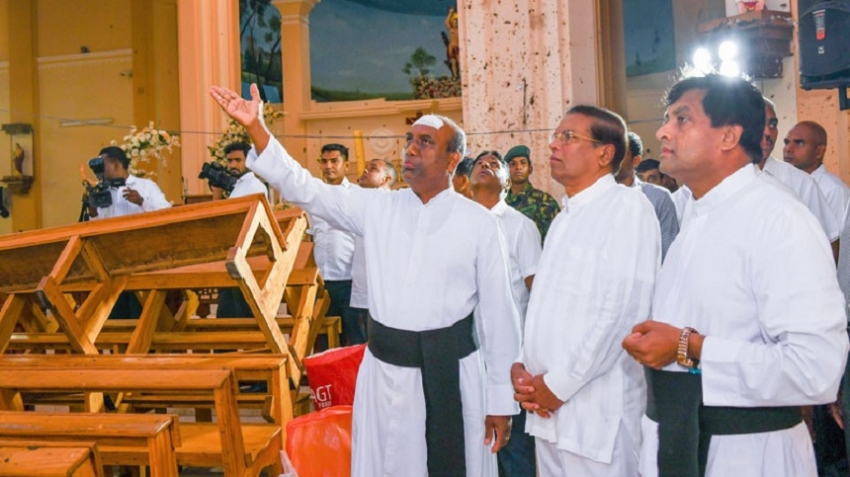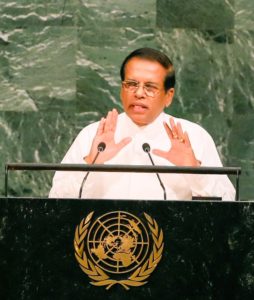
Sri Lanka’s President Maithripala Sirisena visited the recently bombed St. Sebastian’s Church, Katuwapitiya, Negombo Tuesday morning to inspect damages caused to the church. (Courtesy Government of Sri Lanka)
Can the type of terrorist attack that occurred in Sri Lanka on Easter Sunday happen here in the United States?
Last October, eleven people were killed and seven were injured at the Tree of Life – Or L’Simcha Congregation in Pittsburgh, Pennsylvania. It was the deadliest attack on the Jewish community in the United States. In September 2017, a gunman opened fire at the Burnette Chapel Church of Christ in Antioch, Tennessee, killing one person and injuring seven others. The perpetrator was targeting white American churchgoers. And in 2015, a mass shooting happened at the Inland Regional Center in San Bernardino, California that left 14 dead and 22 injured. The two suspects, who were later killed in a gun battle with police, are believed to have been “inspired by foreign terrorist organizations” and radicalized over the internet.
The coordinated attacks on Christian churches and places where tourists congregated that claimed 290 lives and caused up to 500 injuries have been described by that nation’s government as a “new form of terrorism.” Twenty-four people have been arrested. There are concerns that further explosive devices may still be present at diverse locations. An IED (improvised explosive device) was found and deactivated near the Bandaranaike Airport, outside of Colombo, Sri Lanka’s capital city.
World Watch Monitor had previously reported that the National Christian Evangelical Alliance of Sri Lanka described numerous attacks against Christians and Muslims in the past several years, and placed blame on a Buddhist nationalist organization called Bodu Bala Sena (BBS) or the “Buddhist Power Force.” Sri Lanka is 45th on the Open Doors 2017 World Watch List, which ranks the 50 countries where Christians are most under seige for their faith.

President Maithripala Sirisena. (Courtesy Government of Sri Lanka)
According to Reuters, “The Christian community had already felt under pressure in Sri Lanka in recent years. Last year, there were 86 verified incidents of discrimination, threats and violence against Christians … This year … recorded 26 such incidents, including one in which Buddhist monks allegedly attempted to disrupt a Sunday worship service, with the last one reported on March 25.”
Sri Lanka’s total population is approximately 22 million where 70 percent are Buddhist, 12.6 percent are Hindu, 9.7 percent are Muslim and 7.6 percent are Christian, according to the country’s most recent census.
The assaults in Sri Lanka, however, may be the work of an Islamist extremist group (news reports say ISIS has taken credit for inspiring the Easter attacks). Foreign Policy reports that Sri Lanka’s government says the attacks were carried out by National Thowheeth Jama’ath, a little-known radical Islamist group. According to the Straits Times, 10 days before the attacks, a police official warned security authorities about a potential threat to Christians by National Thowheeth Jama’ath. Until recently, National Thowheeth Jama’ath was known primarily in for destroying Buddhist statues. In 2016, its Abdul Razik, described as the groups’ secretary,was arrested and charged for inciting racism. However,The Staits Times noted that Prime Minister Ranil Wickremesinghe said that he and other top government officials had not been informed of the threat, and that “we must look into why adequate precautions were not taken.”
According to international security expert Grant Haber, “Authorities know Sri Lanka could absolutely happen in the US. You can bet there are terrorist plans already in action to attack places of worship in America. For decades I’ve been warning government officials that we’ve been going about the IED crisis the wrong way. We are giving our enemy a huge leg up” says Grant Haber, foremost expert on IED’s and Homemade Explosive Devices, such as the ones used in Sri Lanka. Once contained to troubled and distant lands, pipe bombs and other improvised explosive devices (IEDs) now pose a serious threat to federal, State, and local government facilities here in the United Slates. These devices can be easily and inexpensively assembled and placed in busy population centers. Schools, shopping malls, stadiums and other public places where people walk freely all are potential targets for terrorist attacks. Guarding against terrorist attacks involving IEDs starts with a basic understanding of a typical bomb. People must recognize that a bomb usually is made to look like all everyday widgets and that the stereotypical bombs with burning fuses are virtually non-existent. The only common denominator that exists with all explosive devices is that they are intended to explode. For this reason, it is important to suspect anything that looks unusual, and to let a trained bomb technician determine whether it is an explosive device.”
The Department of Homeland Security notes that “Many commonly available materials, such as fertilizer, gunpowder, and hydrogen peroxide, can be used as explosive materials in IEDs. Explosives must contain a fuel and an oxidizer, which provides the oxygen needed to sustain the reaction. A common example is ANFO, a mixture of ammonium nitrate, which acts as the oxidizer, and fuel oil (the fuel source). Concern about the use of explosives created from liquid components that can be transported in a stable form and mixed at the site of attack is the reason that in 2006 the U.S. Department of Homeland Security restricted the amount of liquids that passengers can carry on commercial aircraft.
Frank Vernuccio serves as editor-in-chief of the New York Analysis of Policy & Government.

















Follow Us